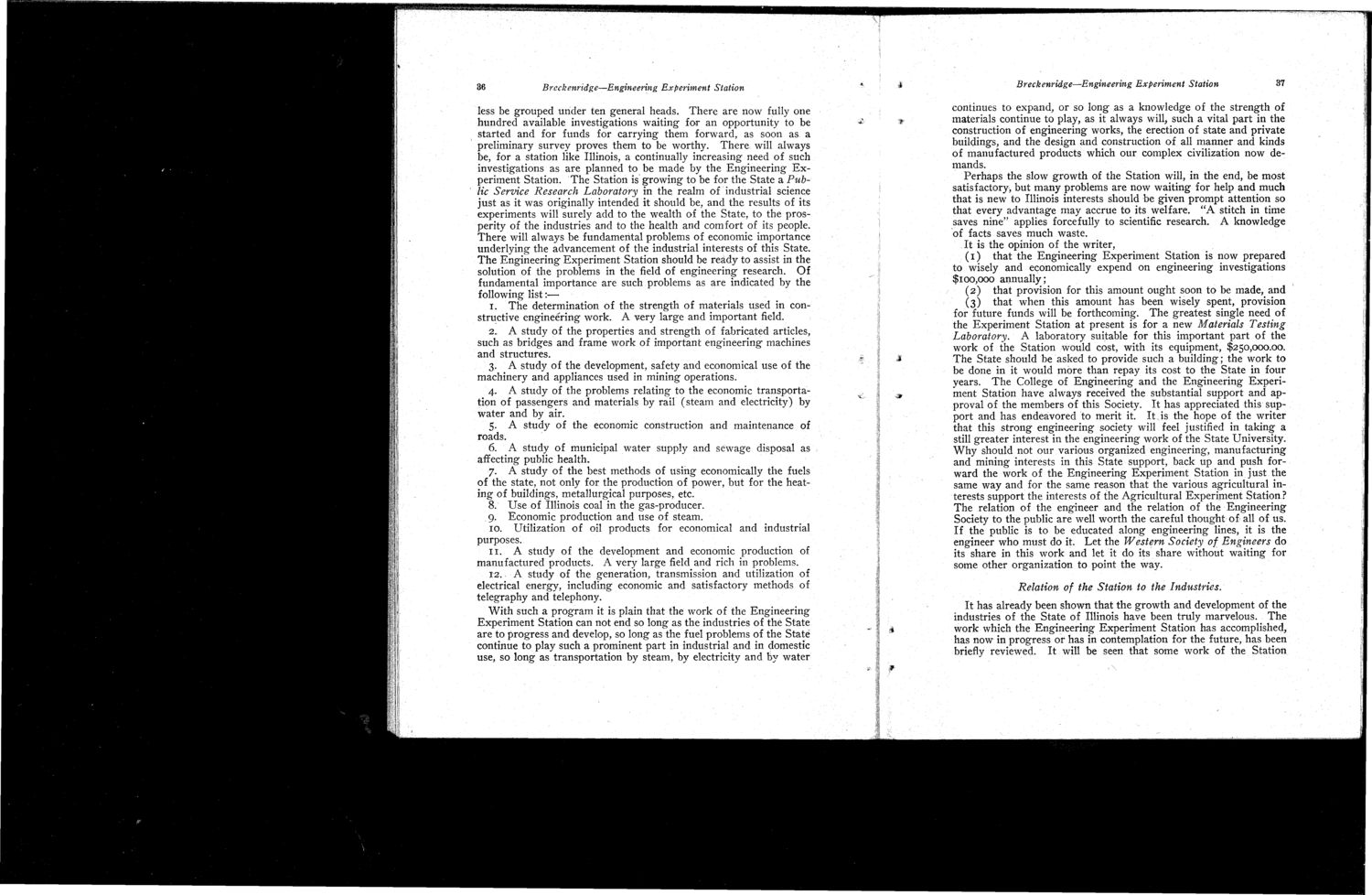| |
| |
Caption: Booklet - Engineering Experiment Station and Industry (1909)
This is a reduced-resolution page image for fast online browsing.

EXTRACTED TEXT FROM PAGE:
36 Brcckenridge—Engineering Experiment Station Breckenridge—Engineering Experiment Station 37 less be grouped under ten general heads. There are now fully one hundred available investigations waiting for an opportunity to be started and for funds for carrying them forward, as soon as a preliminary survey proves them to be worthy. There will always be, for a station like Illinois, a continually increasing need of such investigations as are planned to be made by the Engineering Experiment Station. The Station is growing to be for the State a Public Service Research Laboratory in the realm of industrial science just as it was originally intended it should be, and the results of its experiments will surely add to the wealth of the State, to the prosperity of the industries and to the health and comfort of its people. There will always be fundamental problems of economic importance underlying the advancement of the industrial interests of this State. The Engineering Experiment Station should be ready to assist in the solution of the problems in the field of engineering research. Of fundamental importance are such problems as are indicated by the following list:— i. The determination of the strength of materials used in constructive engineering work. A very large and important field. 2. A study of the properties and strength of fabricated articles, such as bridges and frame work of important engineering machines and structures. 3. A study of the development, safety and economical use of the machinery and appliances used in mining operations. 4. A study of the problems relating to the economic transportation of passengers and materials by rail (steam and electricity) by water and by air. 5. A study of the economic construction and maintenance of roads. 6. A study of municipal water supply and sewage disposal as affecting public health. 7. A study of the best methods of using economically the fuels of the state, not only for the production of power, but for the heating of buildings, metallurgical purposes, etc. 8. Use of Illinois coal in the gas-producer. 9. Economic production and use of steam. 10. Utilization of oil products for economical and industrial purposes. 11. A study of the development and economic production of manufactured products. A very large field and rich in problems. 12. A study of the generation, transmission and utilization of electrical energy, including economic and satisfactory methods of telegraphy and telephony. With such a program it is plain that the work of the Engineering Experiment Station can not end so long as the industries of the State are to progress and develop, so long as the fuel problems of the State continue to play such a prominent part in industrial and in domestic use, so long as transportation by steam, by electricity and by water 1 * * continues to expand, or so long as a knowledge of the strength of materials continue to play, as it always will, such a vital part in the construction of engineering works, the erection of state and private buildings, and the design and construction of all manner and kinds of manufactured products which our complex civilization now demands. Perhaps the slow growth of the Station will, in the end, be most satisfactory, but many problems are now waiting for help and much that is new to Illinois interests should be given prompt attention so that every advantage may accrue to its welfare. "A stitch in time saves nine" applies forcefully to scientific research. A knowledge of facts saves much waste. It is the opinion of the writer, (1) that the Engineering Experiment Station is now prepared to wisely and economically expend on engineering investigations $100,000 annually; (2) that provision for this amount ought soon to be made, and (3) that when this amount has been wisely spent, provision for future funds will be forthcoming. The greatest single need of the Experiment Station at present is for a new Materials Testing Laboratory. A laboratory suitable for this important part of the work of the Station would cost, with its equipment, $250,000.00. The State should be asked to provide such a building; the work to be done in it would more than repay its cost to the State in four years. The College of Engineering and the Engineering Experiment Station have always received the substantial support and approval of the members of this Society. It has appreciated this support and has endeavored to merit it. It is the hope of the writer that this strong engineering society will feel justified in taking a still greater interest in the engineering work of the State University. Why should not our various organized engineering, manufacturing and mining interests in this State support, back up and push forward the work of the Engineering Experiment Station in just the same way and for the same reason that the various agricultural interests support the interests of the Agricultural Experiment Station? The relation of the engineer and the relation of the Engineering Society to the public are well worth the careful thought of all of us. If the public is to be educated along engineering lines, it is the engineer who must do it. Let the Western Society of Engineers do its share in this work and let it do its share without waiting for some other organization to point the way. Relation of the Station to the Industries: It has already been shown that the growth and development of the industries of the State of Illinois have been truly marvelous. The work which the Engineering Experiment Station has accomplished, has now in progress or has in contemplation for the future, has been briefly reviewed. It will be seen that some work of the Station
| |